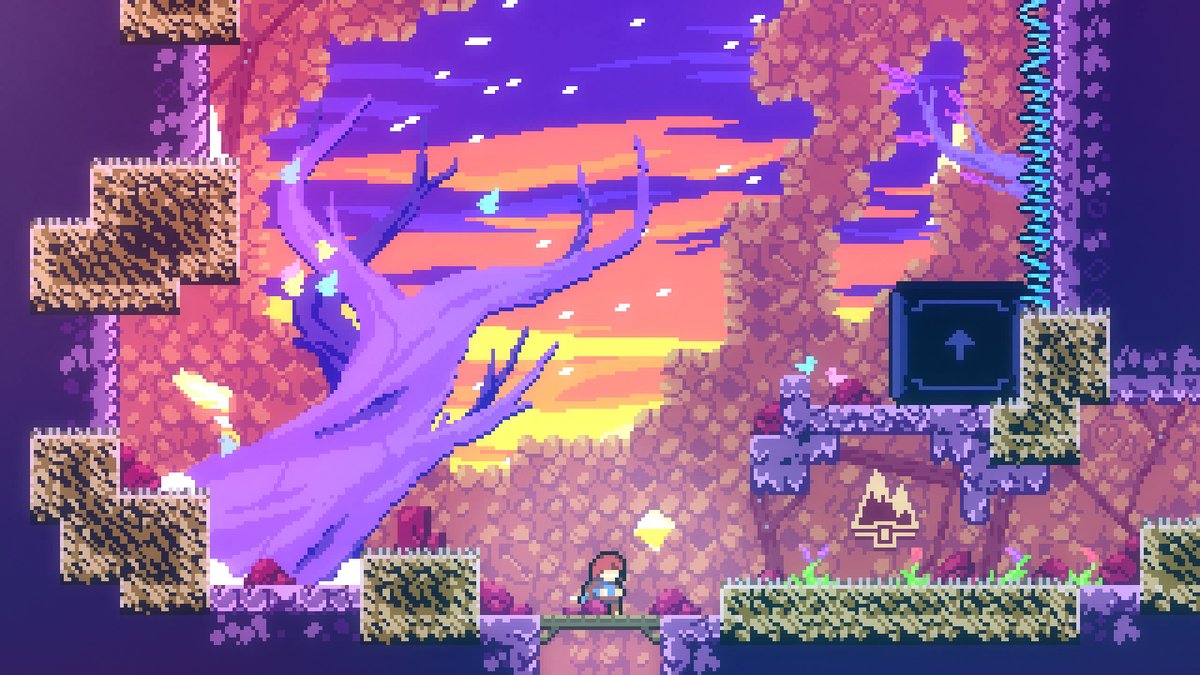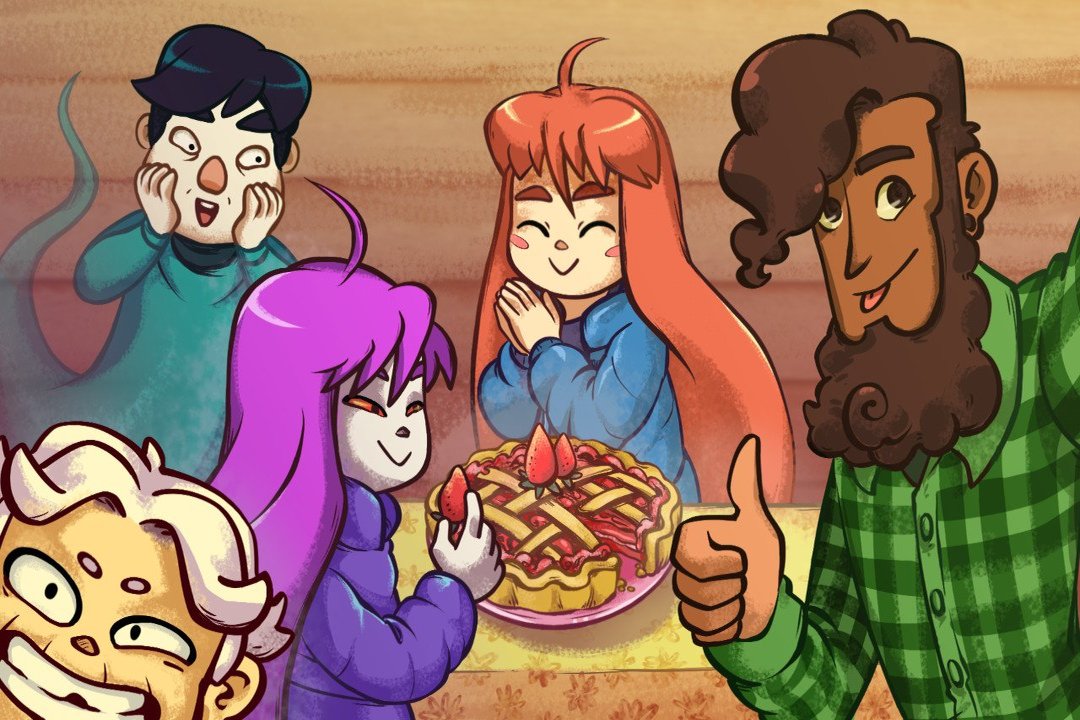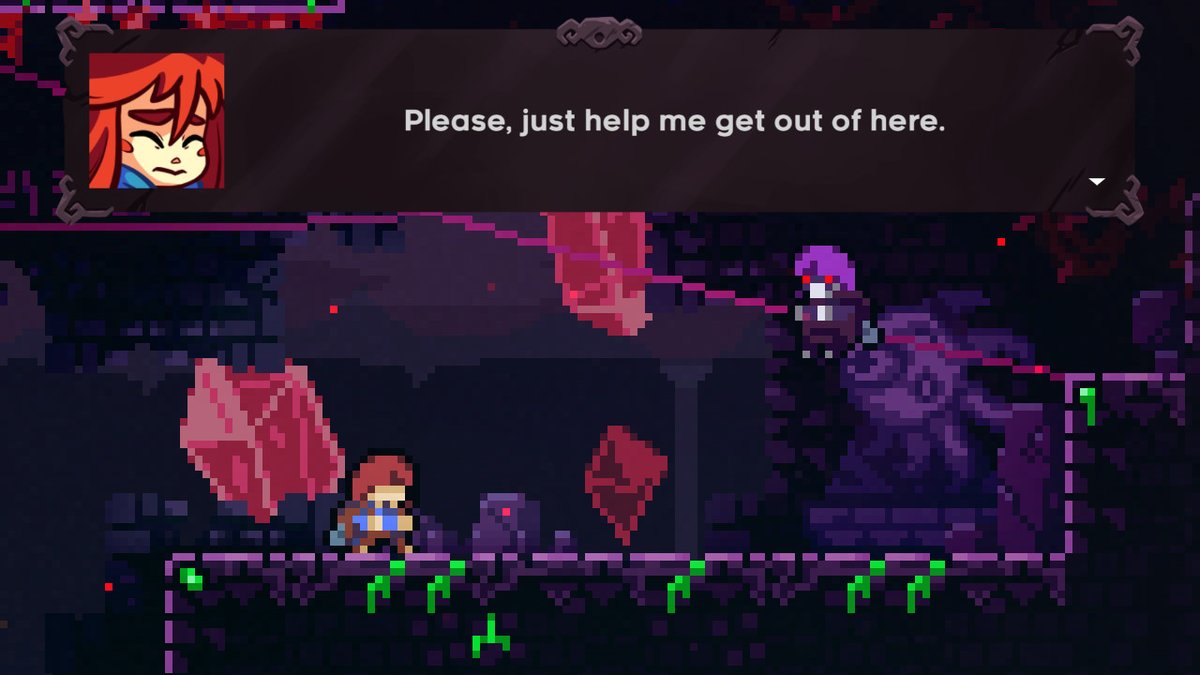Celeste was a pleasant surprise to start off the year for me. I had heard nothing about it before release and had only casually glanced at it once, while walking by a booth for it at PAX West, thinking nothing of it. I remember thinking something along the lines of, “Oh, that looks alright, nothing too special.” At first glance it just looked like another simple, little pixelated platformer, with maybe a few new ideas. I owe the developers a sincere apology, because I severely underestimated what quality and depth lie beneath the game’s simple exterior.
Celeste was developed by the studio Matt Makes Games, headed by Matt Thorson, who also developed Towerfall. It’s a level-based 2D platformer that tells the story of Madeline, a stubborn girl struggling with personal issues who is attempting to climb a treacherous mountain called Celeste, where mysterious history and mystical forces lurk down every forgotten path.
So the stage is set for a grand platforming adventure, and it doesn’t take long for Celeste to start impressing. Because I’ll be blunt — Celeste is one of the best platformers I’ve ever played, and it’s because of nearly everything it does.
 On that note, let’s go over everything, shall we?
On that note, let’s go over everything, shall we?
I Do Not Jest When I Say I Was Impressed By Celeste
Celeste is the kind of 2D platformer that reminds me why I love 2D platformers so much; it’s because they’re the purest type of game there is. You can shape the basics of the genre into any number of things, and all you really need are tight controls, solid core mechanics, and new mechanics over time that build off of the basics without compromising their simplicity. Celeste understands this very well.
The game establishes the basics early on. Madeline can jump (of course), dash in eight different directions, jump off walls, and cling to walls and climb them for a short amount of time, similar to The Legend of Zelda: Breath of the Wild. You can dash once before it must be restored, and you only restore the dash once you touch solid ground, but not a wall, and whether or not you have a dash to spare is indicated by the color of Madeline’s hair.
The dash is the core mechanic around which all of the gameplay and its many twists and turns revolve. Celeste takes this dash and the other basics it establishes from the start and then continues to build on them with loads and loads of clever mechanics and new ideas that change from level to level from start to finish. It also helps that even though you die in one hit, you respawn very quickly, and new checkpoints come with new screens, so any lost progress is, in reality, about 10-20 seconds or less on average.
You have everything from moving blocks that throw you around with momentum, surfaces you can only touch once before they become dangerous, items that recharge your dash in midair, all kinds of new ways to move around, and the list just keeps going.
Every level feels unique with both its mechanics and themes, as well as their relevance in the story, which constantly keeps the game fresh, exciting, and surprising. The variety of obstacles and gradual changes to gameplay gave me pleasant reminders of games like Yoshi’s Island and Shovel Knight, alongside its fantastic level design that is loaded with screen after screen of intelligent design, and packed to the gills with extra secrets and challenges.
By this game’s standards
This isn’t even a hard part#NintendoSwitch pic.twitter.com/VJaABSvyop— Greyson Ditzler (@BrowFurrowed) January 31, 2018
By this game’s standards, this isn’t even a hard part. Also yes, that’s me playing.
To be honest, the only real complaints I have about the game at all have to do with the sometimes ruthless difficulty — which we’ll get to later — and the fact that I at times had some slight issues with the controls. For the most part, Madeline controls very well, and she may be a bit heavier than some other platforming protagonists, but that doesn’t take too long to get used to. The issue I have is that the dash can be a bit temperamental and overly sensitive at times.
Unlike a game like Super Meat Boy, where you always have full control over your character’s range of movement, Madeline can only dash in the eight basic directions, and at times it feels as though in a frantic moment you may accidentally dash sideways instead of up because you were ever so slightly off on the control stick. It didn’t happen terribly often for me, but enough that I noticed it (though to be fair, that was mostly during the very tight and more difficult levels towards the very end and among the bonus content).
This isn’t a deal-breaker, though, as I’m certain this is a minor issue that can be overcome with enough practice, and if you’re good enough with a D-Pad on a controller or the directional buttons on a Switch Joy-Con, then maybe it won’t bother you all that much. Just understand that you need to be patient with the game in general in order to improve over time, and it shouldn’t get to you.
The Young Girl and the Mountain
What especially surprised me about Celeste was how solid and sweet the story was, and how much I could relate to it personally. I’ll do my best not to spoil anything in this review, but I will lightly touch on some of the game’s themes and plot points, so consider this your warning.
Alright? Here we go then.
What I thought was very unique about the story was the way it discusses and portrays mental health issues. It isn’t the deepest or even the strongest narrative about mental health I’ve seen in a game, but it’s nonetheless very genuine, honest, and well executed. It also manages to analogize and explain these complex issues in a straightforward manner without coming across as insensitive, while also making it accessible to a younger audience.
At the start of the game, there’s a bit of mystery as to why Madeline is climbing the mountain in the first place, considering the fact that she has no prior experience, and the task is highly dangerous. The answer to this question really surprised and pleased me; it’s because she thinks she has to.
It’s hinted at from the start and outright revealed some ways into the game that Madeline is struggling with depression, and that climbing Celeste is her way of trying to put her life back on track. This may actually be my favorite aspect of the game, as it puts basically everything else into context, from the strawberries to the darker side of Madeline to the general lack of enemies.
The fact that the mountain is magical and rich with a mysterious history is basically irrelevant to Madeline because she isn’t climbing it for that. There’s no family history with the place or mysterious force that drew her there, or even a great treasure or free wish at the top of the mountain to motivate her. She’s doing it because she thinks overcoming this seemingly impossible monumental task will somehow get her head back in order and give her back control of a life she feels she’s lost control of.
While I can’t guarantee everybody will see eye-to-eye with Madeline on this, speaking as somebody who has depression, this really resonated with me — the idea that overcoming some nonspecific challenge will prove that you can sort out your own life and deal with your own problems, when really the problems are still there with you, and the best but still hardest thing to do is to just try and understand them and then work up from there.
It’s a simple but highly effective aspect of the story that really provided great context for the gameplay and gave it all emotional weight for me. You can easily sympathize with her because she’s perfectly capable of getting things done, but what she’s doing is really hard, and she’s no less vulnerable throughout most of the story, often beating herself up out of a lack of confidence. I just really wanted to see Madeline make it to the summit and see if she felt any better by the end.
The rest of the writing and story elements are pretty solid too. Every character has a distinct personality and serves a purpose in the plot, even if they don’t get much screen time, and the lightness of tone most of the game has manages to blend well with the more serious and sad moments seamlessly. Overall, I came away from the plot liking all the characters and feeling very satisfied with the ultimate conclusion.
All of this is, of course, helped out by the very pleasant presentation. Similar to games like Cave Story and Hyper Light Drifter, Celeste has a colorful pixelated art style that’s just detailed enough to give everything definition, but just simple enough to leave certain details up to the imagination. That, coupled with the excellent and often exhilarating soundtrack, come together to make Celeste feel like a Game Boy Advance game from your wildest dreams.
Celeste’s Layered Difficulty
One thing that you need to know going into Celeste is that it can be very hard. The main game is challenging but curves gently and very naturally as it goes, so it never feels like the difficulty spikes or creeps up on you, but rather progresses naturally.
That’s the first layer of challenge, while the second comes in the form of collecting the strawberries. All throughout each level there are multiple optional routes you can take for additional platforming challenges in order to collect a floating strawberry.
What’s really nice about the strawberries is that they’re completely optional in every way. They’re basically never put in the normal path needed to beat a level, and are usually found on their own separate path or screen, where the player can simply choose to ignore them when they want to. There’s also no explicit reward for collecting them either, which normally I’d harp on considering how hard it is to get many of them, and how many there are, but this is a rare case where I don’t really mind it.
The act of merely collecting the strawberries and discovering more through exploration — which can also lead to additional secrets — is fun, different, and challenging enough that collecting them is their own reward. Not to mention, in the context of the story, it makes sense, considering that the whole trip up the mountain is the reward in itself for Madeline; the strawberries are just a little treat on the side of that. Plus, while there is no direct gameplay benefit from collecting them, there is a slight reward at the end of the story, and grabbing them is fun anyway, so collecting a few couldn’t hurt.
Then there’s the B-Side levels. Which are pure evil.
The B-Side levels are optional challenge levels that you can unlock by finding the corresponding cassette tape in each of the game’s main levels. Like the strawberries, they’re also out of the way of the main path, but a bit more hidden in this case. Once you collect the tape, you unlock an extra-challenging remix of the level that you just completed, albeit more linear and lacking strawberries, serving as a pure platforming challenge. Sorry, did I say challenging? I meant to say MURDEROUSLY CHALLENGING.
The B-Side bonus levels are hard. Insanely hard. And I’m not talking like Super Meat Boy Dark World hard, or even Cuphead on Expert hard. I’m talking like competing the secret ending of Cave Story hard, or even harder. The first one that I tried was the third B-Side level — and no joke — it took me an hour and a half to beat, and I died 832 times. I am not kidding.
This one screen seriously took me like 20 minutes
#NintendoSwitch pic.twitter.com/hWYP7p8UtJ— Greyson Ditzler (@BrowFurrowed) January 31, 2018
This is a screen from that same B-Side level. This one part seriously took me like 20 minutes.
These levels are so hard that it’s almost hard to believe that they’re from the same game as the main story. In contrast to the typical level design, which is generally more open and forgiving, these are much more tightly focused, timing-based to a very specific degree, and completely linear. Words cannot do them justice; they must be played to be believed.
Apparently Matt Thorson was an active member of the Super Mario Maker community, and in these levels, it really shows. A lot of these levels involve the kind of precise platforming that is meant only for super players and the kind of determined experts who are willing to put hours into each level if they have to.
I should say that these levels are still fair and fun like the rest, but the jump in difficulty from the main game is absolutely massive, so be warned. There are rewards directly linked to completing these levels (aside form bragging rights), however, so there’s a little more incentive to keep trying.
Additionally, it was very smart of the devs to make these levels entirely optional. Putting them in the game as a bonus side dish for the feast that is the story and its gameplay means that Celeste has enough difficulty options for everybody, while still keeping to a determined difficulty curve and structure with its normal gameplay.
And while we’re on the subject of feasting, the game is fairly generous with content as well. The main game took me around nine hours to complete, with me collecting 104 strawberries, which is quite a bit longer than I honestly expected, and there’s a ton of extra time and content to be found for the hardcore gamers and completionists out there. At the price of $20, I’d call this game a steal.
You Need to Reach the Summit Just for the View Up There
I’d like to clarify that my score does not mean that Celeste is a perfect game, because it isn’t. By my standards, a score like this is meant for games that aren’t necessarily flawless, but deserve to be played by everybody possible regardless. While the extreme difficulty and odd fiddling with the controls did frustrate me at times, the things that the game does well vastly outweigh its few hiccups.
It’s the consistent variety and inventiveness, the simple but honest and emotional story, the notable amount of content, and the difficulty that gets so nuts it must be seen to be believed that all make this a game a must-play. Celeste is a game I heartily recommend to any fan of platformers, gamers looking for a real challenge, and anybody who wants a good story — so basically everybody. I absolutely loved my time with it, and I’m sure many others will as well. This is a mountain I’d gladly climb back down just to scale the whole thing again.
Celeste is available now for Nintendo Switch, PS4, Xbox One, and Steam. You can watch a trailer for the game down below:








Published: Feb 1, 2018 01:18 pm